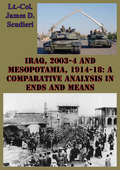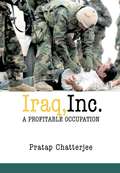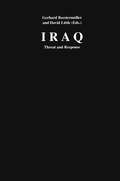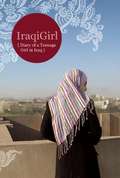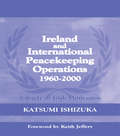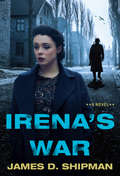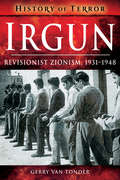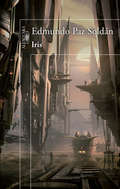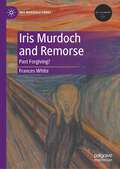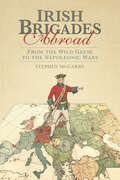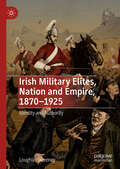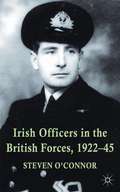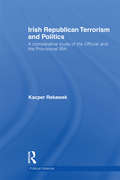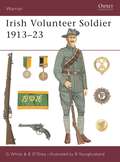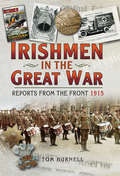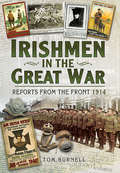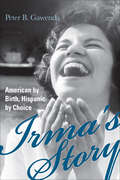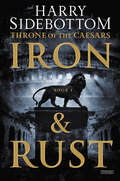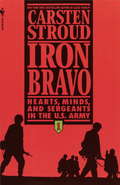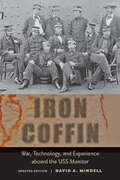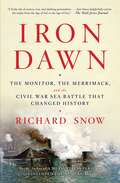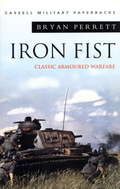- Table View
- List View
Iraq, 2003-4 And Mesopotamia, 1914-18: A Comparative Analysis In Ends And Means
by Lieutenant Colonel James D. ScudieriThis paper is a comparative analysis of the British campaign in Mesopotamia during the First World War, 1914-18 and the current campaign in Iraq, 2003-4. The study focuses on an examination of Phase III decisive operations and Phase IV reconstruction operations, including strategic imperatives, operational planning, and the impact of changes during operations. The British had no campaign plan for Mesopotamia upon the outbreak of war in 1914. Deployment to this theater began as a peripheral operation. Overriding politico-strategic requirements spurred further exploitation to reach Baghdad. Failure to match ends and means resulted in the disastrous surrender of a division at Kut on 29 April 1916. Sweeping reorganization and large-scale reinforcements resumed the advance; Baghdad fell on 11 March 1917. The British conducted ad-hoc reconstruction operations throughout this period, beginning in the Basra vilayet and expanding their scope with the capture of Baghdad. The British established viable civil institutions, to include police forces, a functioning legal system, Revenue and Customs Departments, a banking system, and even domestic mail.Conversely, the recent U.S. strategy of pre-emption in Iraq was a policy decision based upon the wider strategic perspective and benefited from exhaustive operational planning. However, the rolling start campaign utilized minimal forces. They had the capability to win the decisive operations phase rapidly, but this same troop level was woefully inadequate to conduct incompletely-planned, sorely under-estimated, post-conflict operations. Both campaigns suffered from a serious mismatch of ends and means at certain stages, especially for post-war reconstruction operations. They achieved significant success due to herculean efforts in theater. The study concludes with recommendations for strategic leaders related to planning and force structure.
Iraq, Inc.: A Profitable Occupation (Open Media Series)
by Pratap ChatterjeeMore than one year after the "fall of Baghdad," the reconstruction of Iraq was failing terribly. Ordinary Iraqis waited in line for basic necessities like clean water and fuel, while the number of civilians and soldiers killed escalated in tandem with the billions of U.S. tax dollars spent. In Iraq, Inc.: A Profitable Occupation, Pratap Chatterjee delivers an on-the-ground account of the occupation business, exposing private contractors as the only winners in this war.Chatterjee examines the big failings and even bigger swindles of Iraq's corporate managers, from the dangerous follies of an out-of-touch government-in-exile to the unchecked price gouging by Cheney's successors at Halliburton. In Iraq, Inc. Chatterjee contrasts the employment boom of mercenaries--more than 20,000 soldiers of fortune from apartheid-era South Africa, Pinochet's Chile, and elsewhere in Iraq--with the crowds of unemployed locals ripe for recruitment to the resistance.Drawing on years of research and first-hand experience in the region including his live reporting from post-invasion Iraq as he traveled around the country first in December 2003 when Saddam Hussein was captured and in April 2004 during the height of the siege of Fallujah, Chatterjee brings us the dilapidated hospitals, looted ministries, and guarded corporate enclaves that mark the plunderous road to America's free Iraq.
Iraq, Lies, Cover-ups, & Consequences
by Rodney Stichauthor alleges corruption and lies by all three branches of US government support Iraq war after September 11.
Iraq: Threat and Response
by Gerhard BeestermoellerThis volume of essays about the ongoing crisis concerning Iraq is written from the perspective of the "thoughtful opposition." German and American scholars from diverse backgrounds--moral theology, policy analysis, political science, Middle Eastern history--all criticize, albeit sometimes for different reasons, unilateral U.S. military action against Iraq.The chapters are uniformly free of intemperate language and careless argumentation characteristic of much opposition to American foreign policy. The authors address the moral, legal, political, or historical dimensions of the Iraq problem. They also assess the threat Saddam Hussein represents to his region and the world as well as the prospects for alternative strategies. The reasoning is well-informed, sensitive to complexity, and attentive to detail.Contributions include: Klaus Dicke, "Peace Through International Law and the Case of Iraq"; Hans J. Giessmann, "The Dubious Legitimacy of Preventive Military Action against Iraq"; John Langan, "Is Attacking Iraq a Good Idea?" and "Is There a Just Cause for War against Iraq?"; Gerhard Beestermller, "The United States: Legitimate Authority for War against Iraq?"; Drew Christiansen, "Holy See Policy towards Iraq"; Henner Frtig, "Iraq: How Severe is the Threat?"; and David Cortright, Alistair Millar, and George A. Lopez, "Sanctions, Inspections and Containment. Viable Policy Options in Iraq."While Iraq: Threat and Response may not be welcomed by uncritical supporters of U.S. policy, it is a reasoned, compassionate exploration of alternatives to military action in Iraq. The volume is clearly designed to strengthen opposition to unilateral action in the United States and abroad. It will be of great interest to students of foreign policy, military studies, and the Middle East.Gerhard Beestermller is deputy director of the Catholic Institute for Theology and Peace, near Hamburg. His focus of research is political ethics and peace ethics. David Little is T.J. Dermot Dunphy Professor of the Practice in Religion, Ethnicity, and International Conflict and director of Initiatives in Religion and Public Life at Harvard Divinity School. He is the author, with Scott W. Hibbard, of Islamic Activism and U.S. Foreign Policy.
Iraqigirl: Diary of a Teenage Girl in Iraq
by Elizabeth Wrigley-FieldHadiya began her blog just under a year and a half into the U.S. occupation of Iraq. She writes from Mosul, a diverse city with many Sunni Muslims, like Hadiya's family. Mosul has become one center of resistance to the occupation. Hadiya's name is not really Hadiya. We have used pseudonyms for every Iraqi in this story because each of their lives could be in danger if they were identified. But Hadiya is a real teenager in Mosul, and this is her story.
Iraq’s Sunni Insurgency: Iraq's Sunni Insurgency (Adelphi series)
by Ahmed S. HashimFrom 2003 to 2008, the Sunni Arab insurgency in Iraq posed a key challenge to political stability in the country and to Coalition objectives there. This paper explains the onset, composition and evolution of this insurgency. It begins by addressing both its immediate and deeper sociopolitical origins, and goes on to examine the multiple ideological strands within the insurgency and their often conflicting methods and goals. Despite organisational incoherence due to the existence of a large number of competing groups, the insurgency in Iraq sustained a particularly high tempo of operations between 2004 and 2006, causing considerable military and civilian casualties. Some insurgent groups focused on attempting to foment civil war between two of Iraq’s major communities, the Sunni and Shia Arabs and, by late 2006, they had come close to unravelling Iraq and presenting the Coalition with a major defeat. The adoption of a new approach by the US in 2007 helped reduce the level of violence in Iraq. In addition, deep fissures within the insurgency itself, between those fighting for more practical, immediate goals and the transnational Islamists and their local allies fighting for wider-reaching goals – including the promotion of sectarian strife – contributed to the insurgency’s diminution. It remains to be seen whether there will be a widespread recognition among Sunni Iraqis of the need to work with the Coalition to facilitate their community’s reintegration into the new Iraqi body politic.
Ireland and International Peacekeeping Operations 1960-2000
by Katsumi IshizukaThe Republic of Ireland has won its status as a leading contributor to international peacekeeping operations, which has been its key 'foreign policy' since the 1960s. But why is Ireland so keen to be involved? This new book asks and answers this and other key questions about Ireland's close involvement with the EU. It cannot simply be for charitable reasons, so is it because it is a neutral state or because it is a middle power? Overall, is Ireland's peacekeeping policy based on realism and liberalism? The characteristics of peacekeeping operations have changed significantly, especially since the end of the Cold War. Can Ireland survive as a traditional peacekeeping contributor or does it have to change its peacekeeping policy radically? And will it be able to maintain its distance from NATO and the EU in terms of peacekeeping operations? This title attempts to answer all of these questions, drawing on a wide range of resources from literature, Irish and UN documents, to newspapers and interviews.
Irena's War
by James D. Shipman&“Shipman dazzles in this historical tour-de-force based on the real-life story of WWII Polish resistance fighter Irena Sendler . . . spellbinding." —Publishers Weekly (Starred Review)Based on the gripping true story of an unlikely Polish resistance fighter who helped save thousands of Jewish children from the Warsaw ghetto during World War II, bestselling author James D. Shipman&’s Irena&’s War is a heart-pounding novel of courage in action, helmed by an extraordinary and unforgettable protagonist. September 1939: The conquering Nazis swarm through Warsaw as social worker Irena Sendler watches in dread from her apartment window. Already, the city&’s poor go hungry. Irena wonders how she will continue to deliver food and supplies to those who need it most, including the forbidden Jews. The answer comes unexpectedly. Dragged from her home in the night, Irena is brought before a Gestapo agent, Klaus Rein, who offers her a position running the city&’s soup kitchens, all to maintain the illusion of order. Though loath to be working under the Germans, Irena learns there are ways to defy her new employer—including forging documents so that Jewish families receive food intended for Aryans. As Irena grows bolder, her interactions with Klaus become more fraught and perilous. Klaus is unable to prove his suspicions against Irena—yet. But once Warsaw&’s half-million Jews are confined to the ghetto, awaiting slow starvation or the death camps, Irena realizes that providing food is no longer enough. Recruited by the underground Polish resistance organization Zegota, she carries out an audacious scheme to rescue Jewish children. One by one, they are smuggled out in baskets and garbage carts, or led through dank sewers to safety—every success raising Klaus&’s ire. Determined to quell the uprising, he draws Irena into a cat-and-mouse game that will test her in every way—and where the slightest misstep could mean not just her own death, but the slaughter of those innocents she is so desperate to save.
Irgun: Revisionist Zionism, 1931–1948 (History of Terror)
by Gerry van TonderA history of the controversial underground group that employed political violence in its quest to create an independent Israel. Includes photos. In October 1944, the US Office of Strategic Services described the Irgun Tsvai Leumi—National Military Organization—as &“an underground, quasi-military organization with headquarters in Palestine . . . fanatical Zionists who wish to convert Palestine and Transjordan into an independent Jewish state [and] advocate the use of force both against the Arabs and the British to achieve this maximal political goal.&” This book delves into the origins and history of Irgun. In 1925, Ze&’ev Jabotinsky founded the Revisionist Zionism organization, whose secular, right-wing ideology would lead to the formation of the Irgun and, ultimately, of the Likud Party. Commencing operations in the British Mandate of Palestine in 1931, Irgun adopted a mainly guarding role, while facilitating the ongoing immigration of Jews into Palestine. In 1936, Irgun guerrillas started attacking Arab targets. The British White Paper of 1939 rejected the establishment of a Jewish nation, and as a direct consequence, Irgun guerrillas started targeting the British. The authorities executed captured Irgun operatives found guilty of terrorism, while deporting hundreds to internment camps overseas. As details of Jewish genocide—the Holocaust—emerged, Irgun declared war on the British in Palestine. Acts of infrastructural sabotage gave way to the bombing of buildings and police stations, the worst being the bombing of the King David Hotel in Jerusalem—the hub of British operations and administration—in July 1946, killing ninety-one. Freedom fighters or terrorists, Irgun was only dissolved when the independent Jewish state of Israel was born on May 14, 1948. This is their story.
Iris
by Edmundo Paz SoldánUna distopía arrolladora e hipnótica sobre la forma en que se reinventan los individuos en tiempos de guerra, una fábula desoladora sobre los excesos del poder y, al final, un relato esperanzador sobre la lucha por la libertad. <P><P>En un futuro no muy lejano, en una región tóxica llamada Iris, se encuentra el Perímetro, territorio de las fuerzas colonizadoras. En el Perímetro viven Xavier, un soldado que debe lidiar con una traumática herida de combate, y el capitán Reynolds y su unidad, que, cansados ante las victorias de los irisinos liderados por Orlewen, deciden emprender su guerra particular. <P><P>El Perímetro es también el hogar de Yaz, una enfermera que se encuentra allí en busca del jün, planta sagrada que ofrece visiones psicotrópicas y trascendencia. Pero el combate no solo se libra en la capital. La lucha se traslada a Malhado, un valle florido donde -cuentan las leyendas irisinas- vive el temible Malacosa, y a Megara, centro dela explotación minera y de los mitos en torno a Xlött, el dios demoníaco en nombre del cual se inicia la batalla final por la independencia de Iris. <P><P>Iris es una novela de gran originalidad, un paso adelante en la trayectoria de Edmundo Paz Soldán. Desde la primera página, transporta a los lectores a un mundo tenebroso y los somete a su lógica, a su delirio, a su violencia y angustia.
Iris Murdoch and Remorse: Past Forgiving? (Iris Murdoch Today)
by Frances WhiteThis exploration of the crucially important role played by remorse in Iris Murdoch’s philosophical, theological, and political thinking identifies it as a critical concept in her moral psychology and a recurrent theme in her art. Through engagement with Simone Weil, current theories of remorse, trauma theory and Holocaust studies, it offers fresh perspectives on Murdoch’s fiction – particularly the late novels, her radio play The One Alone, and her monograph Heidegger.
Irish Brigades Abroad: From the Wild Geese to the Napoleonic Wars
by Stephen McGarryIrish Brigades Abroad examines the complete history of the Irish regiments in France, Spain, Austria and beyond. Covering the period from King James II’s reign of the three kingdoms of England, Scotland and Ireland in 1685, until the disbandment of the Irish Brigades in France and Spain, this book looks at the origins, formation, recruitment and the exploits of the Irish regiments, including their long years of campaigning from the War of the Grand Alliance in 1688 right through to the Napoleonic Wars in 1815. What emerges is a picture of the old-fashioned virtues of honour, chivalry, integrity and loyalty, of adventure and sacrifice in the name of a greater cause.
Irish Military Elites, Nation and Empire, 1870–1925: Identity and Authority
by Loughlin SweeneyThis book is a social history of Irish officers in the British army in the final half-century of Crown rule in Ireland. Drawing on the accounts of hundreds of officers, it charts the role of military elites in Irish society, and the building tensions between their dual identities as imperial officers and Irishmen, through land agitation, the home rule struggle, the First World War, the War of Independence, and the partition of Ireland. What emerges is an account of the deeply interwoven connections between Ireland and the British army, casting officers as social elites who played a pivotal role in Irish society, and examining the curious continuities of this connection even when officers’ moral authority was shattered by war, revolution, independence, and a divided nation.
Irish Officers in the British Forces, 1922–45
by Steven O’ConnorIrish Officers in the British forces, 1922-45 looks at the reasons why young Irish people took the king's commission, including the family tradition, the school influence and the employment motive. It explores their subsequent experiences in the forces and the responses in independent Ireland to the continuation of this British military connection.
Irish Republican Terrorism and Politics: A Comparative Study of the Official and the Provisional IRA (Political Violence)
by Kacper RekawekThis book examines the post-ceasefire evolutions and histories of the main Irish republican terrorist factions, and the interconnected character of politics and militarism within them. Offering the first comparative study of the two leading Irish republican terrorist movements the Official IRA and the Provisional IRA (PIRA), this book presents the lesser-known Officials’ political-military evolution and analyses whether they could have been role models for the Provisionals. Not only does it compare the terrorism and the politics of the Officials and Provisionals in the aftermath of their seminal ceasefires of 1972 and 1994, it also presents the Irish republican history in a new light and brings to the fore the understudied and disregarded Officials who called their seminal ceasefire twenty-two years before their rivals in 1972. In doing this, the work discusses whether the PIRA might have learned lessons from the bitter and ultimately unsuccessful experience of the Officials. This book goes beyond traditional interpretations of the rivalry and competition between the two factions with the Officials usually seen as non-violent but unsuccessful and the Provisionals less politically inclined and mostly concerned with their armed struggle. Simultaneously, it dispels the myth of the alleged Provisional republican copying of their Official republican counterparts who seemed ready for a political compromise in Northern Ireland more than twenty years before the Good Friday Agreement of 1998. Finally, it comprehensively compares the Officials and the Provisionals within the identified key areas and assesses the two factions’ differences and similarities. . This book will be of much interest to students of Irish politics, terrorism studies, security studies and politics in general.
Irish Volunteer Soldier 1913-23
by Bill Younghusband Gerry WhiteThe political situation in Ireland at the beginning of the 20th century was characterised by crisis and change. Armed rebellion against the British Crown, the prosecution of the Anglo-Irish War, the emergence of the Irish Free State, and the eruption of the Civil War over the treaty with Great Britain ensured that the birth of the modern Irish nation was bloody and difficult. This book details the life of an average Volunteer, and includes the experiences of internment, the lack of established medical facilities for wounded, life on the run, discipline, and typical duties.
Irishmen in the Great War: Reports From The Front 1915
by Tom BurnellIn a quest to to discover the forgotten Irishmen in twenty-seven Irish newspapers, many of which are now obsolete, the author uncovered unbelievable and forgotten newspaper articles, cast aside since the 1920s until now. Following the success of the first book in the series covering 1914, Irishmen in the Great War: Reports from the Front 1915 is a labour of love from author Tom Burnell, containing over 150 hand-picked news stories taken from a selection of twenty-seven Irish newspapers throughout the course of the year. These rare and untapped stories, many of which have not seen the light of day since the 1920s, give a unique insight into life on the front line and on the home front during the First World War.These are the accounts of local men at the front, letters sent home from soldiers in the trenches at Flanders, graphic narratives from allied gun turrets, Irish nuns at Ypres, Irish POWs held in Germany, troops coming under fire on Christmas morning and many more.We are presented with articles explaining the logistical side of supporting the army, from how the men at the front were fed to combating ailments brought about by living in the trenches. A letter from a surgeon of the King's Country Infirmary explains the graphic experiences of everyday life on the front line and the newspapers present feature articles on the use of torpedos, hand grenades, warplanes and more.Translated German letters pay tribute to the courage, stamina and shooting skill shown by the British and letters from British troops remark on the deathly accuracy of the German snipers. We also hear of a Kilkennyman who survived the sinking of the Lusitania and how the attack strengthened the resolve of Irish soldiers on the front.We see letters from lieutenants in the Leinsters, privates in the Munsters at Egypt, the Connaughts at Turkey, a fifteen-year-old soldier of the 18th London Irish Rifles, a Kilmoganny soldier writing to the Kilkenny People during a lull in the fighting, letters explaining how the 2nd Royal Irish Rifles fought at Neuve Chapelle and an officer's harrowing description of a gas attack at Hill 60.Following the success of the first book in the series covering 1914, Irishmen in the Great War: Reports from the Front 1915 is a labour of love from author Tom Burnell, containing over 150 hand-picked news stories taken from a selection of twenty-seven Irish newspapers throughout the course of the year. These rare and untapped stories, many of which have not seen the light of day since the 1920s, give a unique insight into life on the front line and on the home front during the First World War.
Irishmen in the Great War: Reports from the Front 1914
by Tom BurnellTwenty-seven Irish newspapers for the period covering the Great War have been trawled through to deliver the amazing stories of those years which changed the world for ever. These are the accounts of local men at the front; of torpedoed ships; drunken wives; final letters and requests from the trenches. Also eye-witness accounts of the slaughter as it was happening; battle reports from officers serving in Irish regiments; quirky snippets; chaplains' sympathetic letters; P.o.W reports of conditions and war poetry. Here are the tales of the Leinster's, Munster's, Connaught's and Dublin Fusiliers serving in the Ulster Division, 10th and 16th Irish Divisions. We read of medical breakthroughs, paranormal occurrences and miraculous escapes from death. After the Irish Rebellion of April, 1916, these type of articles and casualty lists dwindled to very few as Irish hearts became divided.As featured on Tipp FM and in the Tipperary Star and Dungarvan Observer.
Irma's Story: American by Birth, Hispanic by Choice (Irma's Story Ser.)
by Peter B. Gawenda“The compelling true story of the impassioned love shared between a south Texas woman of Hispanic descent and a German military officer.” —Yvonne Freeman, PhD, professor, Department of Language, Literacy, and Intercultural Studies at the University of Texas at BrownsvilleAfter World War II, Peter, a handsome German pilot, met Irma, a beautiful Texan woman of Hispanic descent. It was love at first sight. Their meeting had been prophesized—for Irma by her grandmother and for Peter by a palm reader—and together the couple would create an extraordinary life. Irma’s Story: American by Birth, Hispanic by Choice chronicles Irma’s life and the experiences of the “Texan Gawendas” during their tenure in the German military in Europe and the United States. Though Irma, accepted as an American while in Europe, faced discrimination in her home country and contended with the challenges of being a military wife, Peter’s love and companionship remained constant.In his second book, Peter B. Gawenda, author of The Children’s War, offers readers an insider’s view of the joys that the marriage of two people—from two completely different worlds—can bring. Presenting the dynamics of racial issues against the backdrop of military life, the captivating story of Irma Lozano de Gawenda depicts a fearless, fiercely loyal woman willing to do anything for her family.Written with a passion that has spanned five decades, Irma’s Story celebrates the strength of a once-in-a-lifetime love.“He thrills [readers] again, turning to his narrative gifts and rich trove of memories to tell another story with universal appeal—the power of enduring love.” —Robert Becker, veteran journalist and former international wire news editor, Houston Chronicle
Iron & Rust: Throne Of The Caesars: Book 1 (Throne of the Caesars #1)
by Harry SidebottomA military hero enters a world of intrigue as he becomes the new Roman emperor in this series opener for fans of Bernard Cromwell & George R. R. Martin.Blending heart-pounding action and historical accuracy, Harry Sidebottom’s bestselling Warrior of Rome series took readers from the shouts of the battlefield to the whisperings of the emperor’s inner circle. Now, Sidebottom sets his sights on one of the bloodiest periods of Roman history—the Year of the Six Emperors. In spring AD 235, a surprise attack and the brutal murder of Emperor Alexander and his mother ends the Severan dynasty and shatters four decades of Roman certainty. Military hero Maximinus Thrax is the first Caesar risen from the barracks. A simple man of steel and violence, he will fight for Rome unconditionally. The Senators praise the new Emperor with elaborate oratory, but will any of them accept a Caesar who was once a shepherd boy? In the north, as the merciless war against the barbarians consumes men and treasure, rebellion and personal tragedy drive Maximinus to desperate extremes, bloody revenge, and the borders of sanity . . . Iron & Rust creates a world both sophisticated and brutal, yet firmly rooted in history. Game of Thrones-meets-300: Rise of an Empire, this is a world of intrigue, murder, passion, and war—a world where men will kill to sit on the Throne of the Caesars.Praise for Iron & Rust“[Sidebottom] paints a rich and thorough picture of the Roman world, complete with intrigue and brutality.” —Historical Novel Society
Iron Bravo
by Carsten StroudFirst Sergeant Dee Crane, a Vietnam Eleven Bravo, recounts his experiences alongside his men, his duties at the National Training Center in the Mojave Desert, and his most recent encounters in the Persian Gulf.
Iron Coffin: War, Technology, and Experience aboard the USS Monitor (Johns Hopkins Introductory Studies in the History of Technology)
by David A. MindellThe USS Monitor famously battled the CSS Virginia (the armored and refitted USS Merrimack) at Hampton Roads in March 1862. This updated edition of David A. Mindell's classic account of the ironclad warships and the human dimension of modern warfare commemorates the 150th anniversary of this historic encounter.Mindell explores how mariners—fighting "blindly," below the waterline—lived in and coped with the metal monster they called the "iron coffin." He investigates how the ironclad technology, new to war in the nineteenth century, changed not only the tools but also the experience of combat and anticipated today’s world of mechanized, pushbutton warfare. The writings of William Frederick Keeler, the ship’s paymaster, inform much of this book, as do the experiences of everyman sailor George Geer, who held Keeler in some contempt. Mindell uses their compelling stories, and those of other shipmates, to recreate the thrills and dangers of living and fighting aboard this superweapon. Recently, pieces of the Monitor wreck have been raised from their watery grave, and with them, information about the ship continues to be discovered. A new epilogue describes the recovery of the Monitor turret and its display at the USS Monitor Museum in Newport News, Virginia.This sensitive and enthralling history of the USS Monitor ensures that this fateful ship, and the men who served on it, will be remembered for generations to come.
Iron Coffins: A Personal Account of the German U-Boat Battles of World War II
by Herbert A. WernerFrom the Foreword by Captain Edward L. Beach, U.S. Navy (Ret.) "Madness!" cries Werner, and it was madness. But there were heroes, too, who deserve admiration even though their cause was wrong.... No one can fault the warrior who believes in his country so strongly that he dies for it.... Because their leaders told them so, they believed that if they fought desperately, they might save their country from the disaster plainly grinding in from every side. They expected death, and most of them found it, but they fought hard all the same, and they carpeted the ocean floor with their bodies.
Iron Dawn: The Monitor, the Merrimack, and the Civil War Sea Battle that Changed History
by Richard SnowFrom acclaimed popular historian Richard Snow, who "writes with verve and a keen eye" (The New York Times Book Review), the thrilling story of the naval battle that not only changed the Civil War but the future of all sea power.No single sea battle has had more far-reaching consequences than the one fought in the harbor at Hampton Roads, Virginia, in March 1862. The Confederacy, with no fleet of its own, built an iron fort containing ten heavy guns on the hull of a captured Union frigate named the Merrimack. The North got word of the project when it was already well along, and, in desperation, commissioned an eccentric inventor named John Ericsson to build the Monitor, an entirely revolutionary iron warship--at the time, the single most complicated machine ever made. Abraham Lincoln himself was closely involved with the ship's design. Rushed through to completion in just 100 days, it mounted only two guns, but they were housed in a shot-proof revolving turret. The ship hurried south from Brooklyn (and nearly sank twice on the voyage), only to arrive to find the Merrimack had arrived blazing that morning, destroyed half the Union fleet, and would be back to finish the job the next day. When she returned, the Monitor was there. She fought the Merrimack to a standstill, and saved the Union cause. As soon as word of the battle spread, Great Britain--the foremost sea power of the day--ceased work on all wooden ships. A thousand-year-old tradition ended, and the path to the naval future opened. Richly illustrated with photos, maps, and engravings, Iron Dawn is the irresistible story of these incredible, intimidating war machines. Historian Richard Snow brings to vivid life the tensions of the time, explaining how wooden and ironclad ships worked, maneuvered, battled, and sank. This full account of the Merrimack and Monitor has never been told in such immediate, compelling detail.
Iron Fist: Classic Armoured Warfare (W&N Military)
by Bryan PerrettThe greatest tank battles of history from the Great War to the Gulf, examined by one of Britain's bestselling military writers.The story of the evolution of armoured warfare in the 20th century, which has seen tanks and other armoured vehicles develop from lumbering, primitive and vulnerable Goliaths to the immensely potent and manoeuvrable agents of lightning battlefield success. This is a collection of the greatest moments of armoured history from the conception of the tank as a means to break the stalemate of the Western Front to Blitzkreig, the great tank battles of the Second World War and the 'mother of all battles' in the Gulf in 1991.
